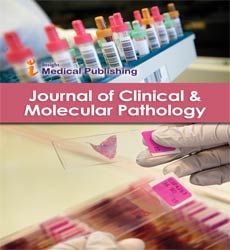ISSN : 2634-7806
Journal of Clinical and Molecular Pathology : Open Access
A Brief Note on Clinical Molecular Pathology
Arif Lestari*
Department of Pathology, Padjadjaran University, Jawa Barat, Indonesia
- *Corresponding Author:
- Arif Lestari, Department of Pathology, Padjadjaran University, Jawa Barat, Indonesia, Tel: 0066259548882; E-mail: arif.lestari@gmail.com
Received: March 16, 2022, Manuscript No. IPJCMPY-22-12137; Editor assigned: March 19, 2022, PreQC No. IPJCMPY-22-12137 (PQ); Reviewed: April 02, 2022, QC No. IPJCMPY-22-12137; Revised: 5-Apr-2022, Manuscript No. IPJCMPY-22-12137 (R); Published: April 08, 2022, DOI: 10.36648/IPJCMPY/22.6.2
Citation: Lestari A (2022) A Brief Note on Clinical Molecular Pathology. J Clin Mol Patho Vol:6 No:1
Abstract
Molecular pathology is a new branch of pathology that focuses on the research and diagnosis of disease by looking at molecules within organs, tissues and physiological fluids.
Introduction
Molecular pathology is a new branch of pathology that focuses on the research and diagnosis of disease by looking at molecules within organs, tissues, and physiological fluids. Molecular pathology is widely employed in the diagnosis of cancer and infectious diseases. The Molecular Pathology Laboratory provides molecular diagnostic testing for a wide range of clinical indications throughout the health-care continuum, including disease susceptibility testing, population screening, diagnosis, prognosis, therapeutic decision-making, and disease monitoring. The testing of nucleic acids in a clinical setting is referred to as molecular pathology. Molecular diagnostics has applications in a variety of human conditions, including genetic, neoplastic, and infectious diseases.
Description
Molecular pathology procedures, according to the American Medical Association's Current Procedural Terminology (CPT) manual, are medical laboratory procedures involving nucleic acid analyses to detect variants in genes that may be indicative of germline or somatic. Clinical pathology uses laboratory testing of blood and other body fluids and tissues, as well as microscopic examination of individual cells, to aid in illness diagnosis. Most importantly, laboratories are having a stronger impact on patient treatment and care by implementing molecular diagnostics. These cutting-edge systems are assisting clinicians in treating infectious infections more quickly and precisely. The study of tissues, organs, and cancers is known as anatomic pathology. The study of cellular alterations and everything connected to cells was known as cytopathology. Autopsies and legal pathology tests are performed by forensic pathology. The study of DNA and RNA sequencing, genes, and genetics was known as molecular pathology. Due to a lack of benefit category (preventive service) and/or failing to meet the reasonable and necessary standard for coverage, several molecular pathology procedures are not covered by Medicare. The Department of Pathology, Microbiology, and Immunology's graduate programme in Cellular & Molecular Pathology provides training in biochemical, cell, and molecular biological research to unravel the fundamental mechanisms of human disease processes.
Conclusion
Sequencing technology is evolving in various directions, and all pathology disciplines are expected to require some sort of sequencing technology. Whole Genome Sequencing (WGS), which may be done at birth, could eventually replace newborn screening, offer lifelong pharmacogenetic data, and provide risk-based illness screening. This could be done in large, automated labs, but we're already witnessing the advent of highly capable benchtop or smaller tools that can provide rapid diagnostic sequencing of known mutations or microbial resistance genes. In microbiology and blood sciences laboratories, Mass Spectroscopy (MS) is becoming ubiquitous. Newer high-throughput technologies and equipment tailored to specific applications are increasingly capable of revolutionizing diagnosis. MS has the potential to offer relatively low-cost results, yet the necessary equipment is now prohibitively expensive. Anatomic pathologists look at samples taken from organs and other tissues that are usually obtained by surgery. Clinical pathologists examine physiological fluids like urine, blood, and saliva for signs of disease. Pathologists are frequently in charge of molecular pathology and biomarkers, which study molecular and genomic abnormalities in tissues for diagnostic and prognostic purposes. They are frequently evaluated in terms of their practical use rather than the significance of their findings for the genetic foundation of tumor kinds.
Open Access Journals
- Aquaculture & Veterinary Science
- Chemistry & Chemical Sciences
- Clinical Sciences
- Engineering
- General Science
- Genetics & Molecular Biology
- Health Care & Nursing
- Immunology & Microbiology
- Materials Science
- Mathematics & Physics
- Medical Sciences
- Neurology & Psychiatry
- Oncology & Cancer Science
- Pharmaceutical Sciences
